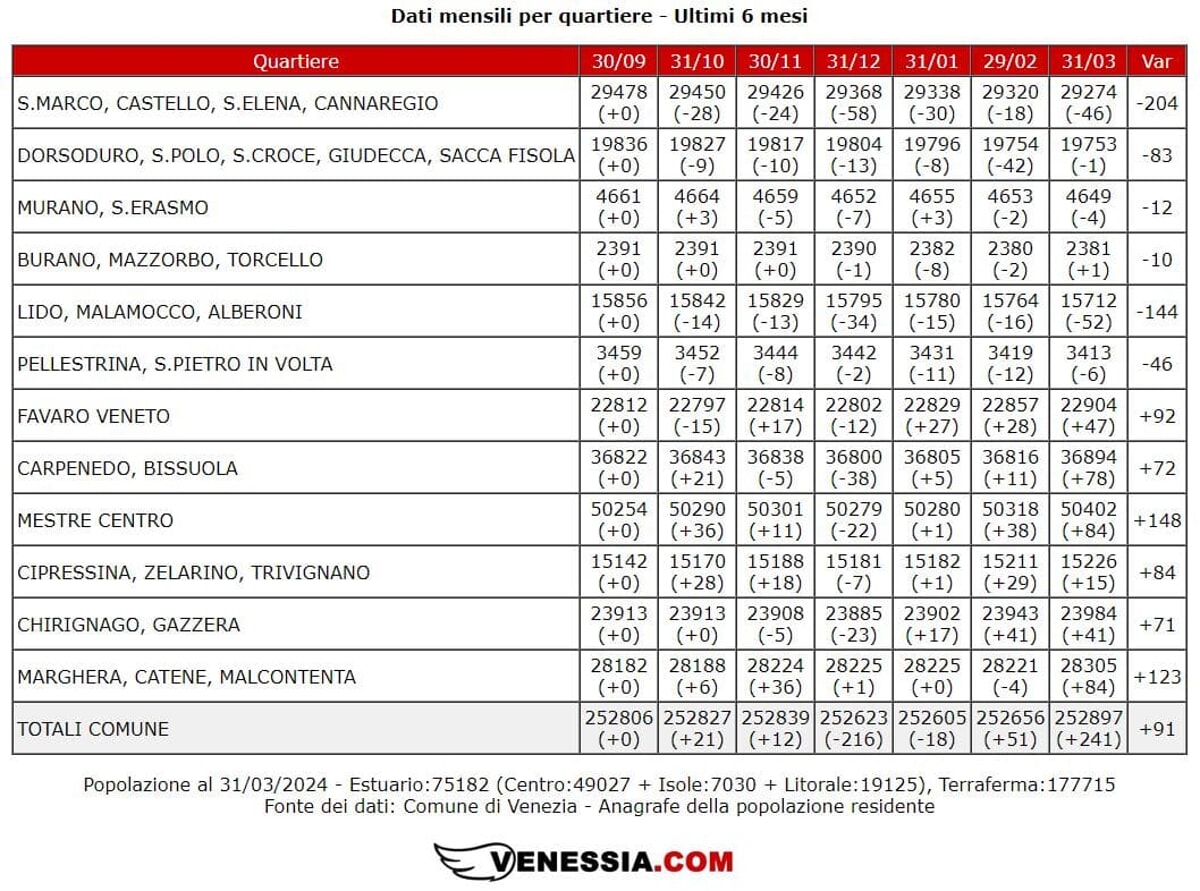
Urban planner Laura Fregolent (Iuav): “In addition to the figure of the decline in the birth rate, there is an objective absence of policies useful for reversing the trend. The main issue is housing”
3 April 2024
[Ed. Note: this site has been quiet for a month or so due to a variety of things involving your faithful editor. But we are back – and will be posting directly from Venice for the next month. Thank you.]
On the morning of April 2nd Venessia.com, the association that has been documenting the depopulation of the Venice Lagoon since 2000, published data regarding the change in the number of residents in the last six months, from September 2023 to March 31. The only real surprise was the slightly positive figure for the entire municipal territory: +91, thanks to a small boom on the mainland, +590 residents in six months, compared to an almost equivalent but slightly lower decline on the islands. Mestre Centro and Marghera are growing in particular, while Castello and Lido show pronounced decline. Thus in the selected time frame it is a series of plus signs for mainland areas, but a series of minus signs for areas in the lagoon.
None of this is new. Rather it is the confirmation of a trend that has continued for some time (both the lagoon and the mainland have lost inhabitants over the last ten years, so in this sense the six-month data have limited relevance). Now, in the next few days that trend will bring residents of “central” Venice (the main islands and Giudecca, following the categorization by the municipal registry office) below the threshold of 49,000 inhabitants. The entire lagoon area now has 75,000 inhabitants, compared to 178,000 on the mainland.
The Mayor of Venice, Luigi Bugnaro, commenting on the data, associated it with a structural demographic decline: every year “we go below the threshold of the previous year, because Venice is a city of elderly people. Italy, together with Japan – he noted – is the oldest country in the world, because no children are born. But this did not start today; it is a phenomenon that has been going on for 30 years”. Nonetheless the Mayor admitted, “we must create the conditions for doing well in the city”.
For Laura Fregolent, professor of urban planning at IUAV and co-author of the volume Abitare Venezia (Anteferma 2023), the decidedly real issue of demographic decline is only one of the explanations for the phenomenon, which in fact affects different areas of the city in different ways. For Fregolent, in addition to an undeniable fact of the declining birth rate, there is an equally undeniable fact that concerns “the inactivity regarding policies that can reverse the current trend”. The areas that are losing the most inhabitants in the historic city are those, like Castello, which have experienced more tourist pressure than others in recent decades, which has particular impact on the possibility of finding a home. “If a person can’t find a home, why should they stay here? To make a city attractive you need services, ease of finding a home and accommodation, and work. However, paradoxically work can be found in Venice: housing is the real issue”. This is true to the extent that many of the new residents on the mainland, including immigrants, actually work on the islands. “It is no coincidence that the older parts of the city are the insular ones, while the younger ones are on the mainland, in neighborhoods with many immigrants. Housing policies are needed, and should also be used to take fragile categories into account, to create cities that are mixed, lively places for everyone.” If a city falls below a certain threshold of residents, the urban planner notes, the entire social and urban fabric is affected. Nevertheless, the blame certainly cannot be placed entirely on the administration of Venice: the declining birth rate and emigration affect the entire region and the country.
Source: Venezia Today

Thank you as always!
Mary Ann DeVliegma@dialogart.orgItaly: +39 392 034 8945PhD CandidateCentre for Socially Engaged Practice-Based ResearchTU Dublinhttp://www.tudublin.ie/seprhttps://www.tudublin.ie/research/discover-our-research/research-institutes-centres-and-groups/sepr/doctoral-candidates/International Arts Rights Advisors:IARA: iara.live Sent from phone
<
div dir=”ltr”>
<
blockquote type=”cite”>
LikeLike